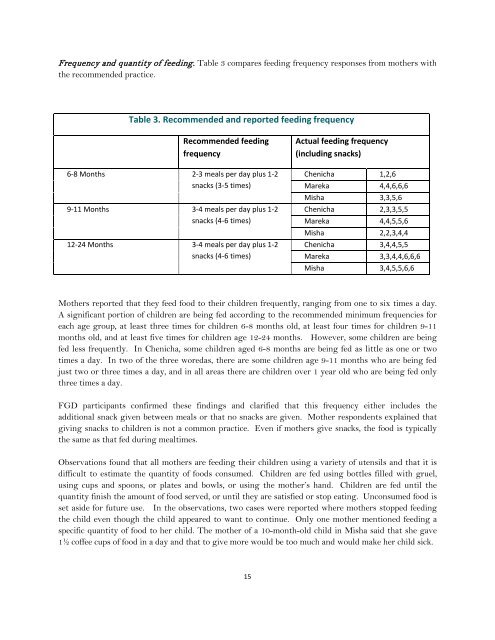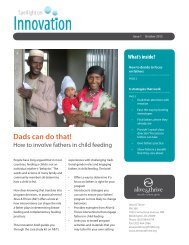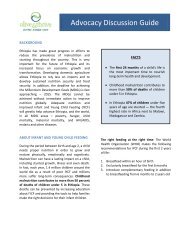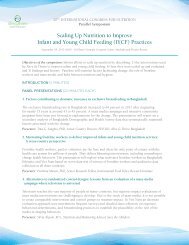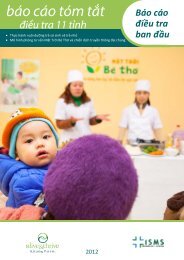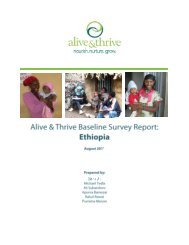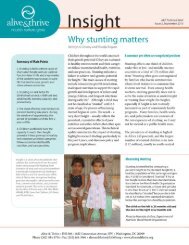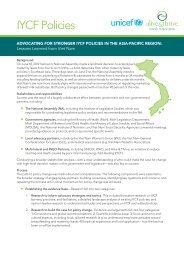Consistency of foods. Children are be<strong>in</strong>g fed various gruels <strong>and</strong> porridges, although observationsshowed that these mixtures are often th<strong>in</strong> <strong>and</strong> liquid. Opportunistic observations showed that childrenare eat<strong>in</strong>g gruels <strong>and</strong> porridges from multiple gra<strong>in</strong>s, milk, <strong>and</strong> chiko (maize flour, kale, fenugreek). Theporridges <strong>and</strong> gruels are typically made from barley <strong>and</strong> rye, with peas, beans or lentils. One motheradded sugar <strong>and</strong> another added butter to the gruel. In two cases of younger children, the gruel wasth<strong>in</strong>ned with breastmilk. Two of the older children were given only kocho softened with milk or godere(a variety of taro/colocasia).Mothers <strong>in</strong> all three areas agreed that special foods need to be prepared separately for young childrenbecause they are too young to digest family food <strong>and</strong> need special food to grow healthy. Thereappeared to be some difficulty differentiat<strong>in</strong>g between semi-solid <strong>and</strong> liquid foods <strong>and</strong> many childrenwere be<strong>in</strong>g fed very th<strong>in</strong> gruels. Though most mothers <strong>in</strong>terviewed said that food with the consistencyof mashed banana should be given to children, dur<strong>in</strong>g observations, gruels were found to be th<strong>in</strong>, withone mother <strong>in</strong> Chenicha prepar<strong>in</strong>g gruel as th<strong>in</strong> as milk. Many mothers said that thick porridge shouldbe given to a 7-month-old child, although some completely disagreed with the idea. The reasons not togive thick porridge were: the porridge is not easily digestible for a child at this age, it is heavy for thisage, <strong>and</strong> the child may choke or have abdom<strong>in</strong>al illness. In all three areas, there were mothers who saidthick foods such as gruel <strong>and</strong> porridge should be given only after the child is 1 year old.“Thick foods stay <strong>in</strong> the child’s stomach for a longer time <strong>and</strong> make the baby fat.” -Amother <strong>in</strong> Chenicha“I would not recommend that a mother give thick porridge to her 7-month-old childbecause this k<strong>in</strong>d of porridge is heavy <strong>and</strong> will not be digested easily at this age. The childalso can’t chew <strong>and</strong> swallow this food. Instead I would advise her to give gruel.” -A mother<strong>in</strong> ChenichaMost mothers talked of prepar<strong>in</strong>g food separately for the child. There was little mention of tak<strong>in</strong>g foodprepared for the family <strong>and</strong> mash<strong>in</strong>g it to make a soft food for the child.Transition to family foods. In addition to feed<strong>in</strong>g young children gruels <strong>and</strong> porridge, mothers saidthat after children are 1 year old, they could eat from family food. Mothers stated that it is notappropriate to give family foods to children younger than 1 year old s<strong>in</strong>ce these children have no teethto chew the foods. Focus group discussion responses varied about the age at which children can startshar<strong>in</strong>g family food. Some <strong>in</strong>formants from Chenicha said the child could be served the family food at 1year or when it starts walk<strong>in</strong>g, while others said 2 to 4 years or even up to 5 or 6 years, <strong>in</strong> Mareka.Dur<strong>in</strong>g <strong>in</strong>terviews <strong>and</strong> focus group discussions, participants said that a child can share family food whenthey are old enough to sit with family members for a meal. At this po<strong>in</strong>t, the child eats the same food,from the same dish as the family. When asked about family foods that are not good for children, rootcrops were often mentioned; more specifically, godere was commonly mentioned <strong>in</strong> Mareka <strong>and</strong> tseguramd<strong>in</strong>ich (hairy potato) <strong>in</strong> Chenicha.“If a child is above the age of 1 year he can eat family foods like bread prepared frommaize, <strong>and</strong> also godere three times a day. But children younger than 1year old can’t chew<strong>and</strong> swallow thick, hard foods.” -A mother <strong>in</strong> Mareka14
Frequency <strong>and</strong> quantity of feed<strong>in</strong>g. Table 3 compares feed<strong>in</strong>g frequency responses from mothers withthe recommended practice.Table 3. Recommended <strong>and</strong> reported feed<strong>in</strong>g frequencyRecommended feed<strong>in</strong>gfrequency6-8 Months 2-3 meals per day plus 1-2snacks (3-5 times)9-11 Months 3-4 meals per day plus 1-2snacks (4-6 times)12-24 Months 3-4 meals per day plus 1-2snacks (4-6 times)Actual feed<strong>in</strong>g frequency(<strong>in</strong>clud<strong>in</strong>g snacks)Chenicha 1,2,6Mareka 4,4,6,6,6Misha 3,3,5,6Chenicha 2,3,3,5,5Mareka 4,4,5,5,6Misha 2,2,3,4,4Chenicha 3,4,4,5,5Mareka 3,3,4,4,6,6,6Misha 3,4,5,5,6,6Mothers reported that they feed food to their children frequently, rang<strong>in</strong>g from one to six times a day.A significant portion of children are be<strong>in</strong>g fed accord<strong>in</strong>g to the recommended m<strong>in</strong>imum frequencies foreach age group, at least three times for children 6-8 months old, at least four times for children 9-11months old, <strong>and</strong> at least five times for children age 12-24 months. However, some children are be<strong>in</strong>gfed less frequently. In Chenicha, some children aged 6-8 months are be<strong>in</strong>g fed as little as one or twotimes a day. In two of the three woredas, there are some children age 9-11 months who are be<strong>in</strong>g fedjust two or three times a day, <strong>and</strong> <strong>in</strong> all areas there are children over 1 year old who are be<strong>in</strong>g fed onlythree times a day.FGD participants confirmed these f<strong>in</strong>d<strong>in</strong>gs <strong>and</strong> clarified that this frequency either <strong>in</strong>cludes theadditional snack given between meals or that no snacks are given. Mother respondents expla<strong>in</strong>ed thatgiv<strong>in</strong>g snacks to children is not a common practice. Even if mothers give snacks, the food is typicallythe same as that fed dur<strong>in</strong>g mealtimes.Observations found that all mothers are feed<strong>in</strong>g their children us<strong>in</strong>g a variety of utensils <strong>and</strong> that it isdifficult to estimate the quantity of foods consumed. Children are fed us<strong>in</strong>g bottles filled with gruel,us<strong>in</strong>g cups <strong>and</strong> spoons, or plates <strong>and</strong> bowls, or us<strong>in</strong>g the mother’s h<strong>and</strong>. Children are fed until thequantity f<strong>in</strong>ish the amount of food served, or until they are satisfied or stop eat<strong>in</strong>g. Unconsumed food isset aside for future use. In the observations, two cases were reported where mothers stopped feed<strong>in</strong>gthe child even though the child appeared to want to cont<strong>in</strong>ue. Only one mother mentioned feed<strong>in</strong>g aspecific quantity of food to her child. The mother of a 10-month-old child <strong>in</strong> Misha said that she gave1½ coffee cups of food <strong>in</strong> a day <strong>and</strong> that to give more would be too much <strong>and</strong> would make her child sick.15


